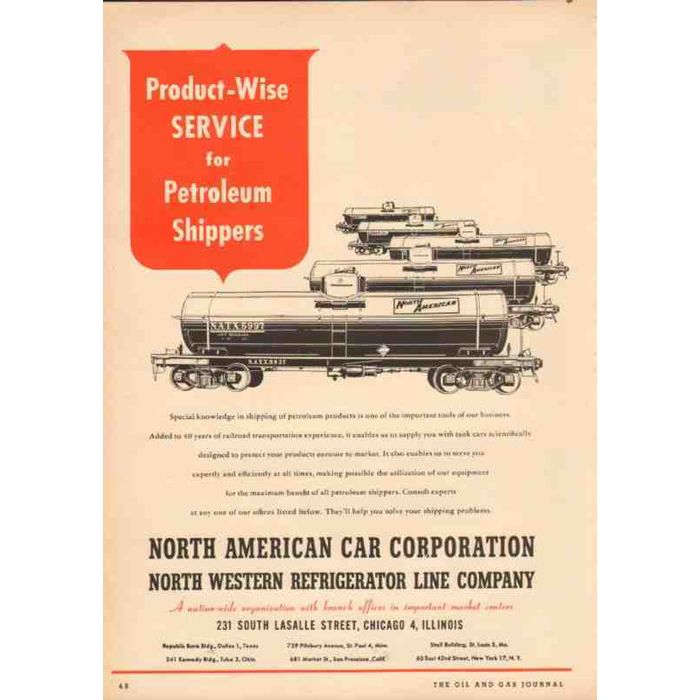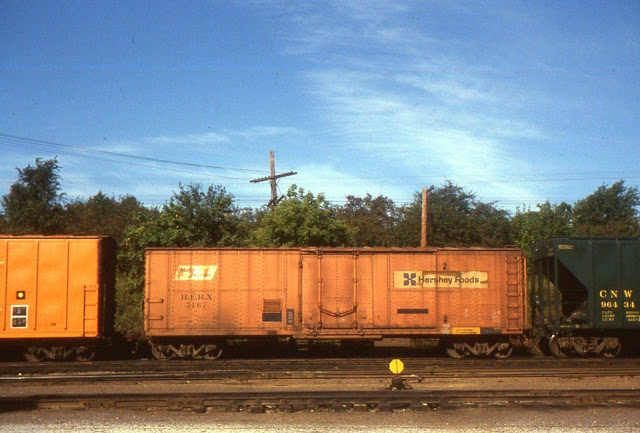Model Information: MODEL FEATURES:
- Three road numbers
- Etched metal stirrup steps
- Fully-assembled and ready-to-run out of the box
- Accurately painted and printed
- Highly detailed, injection molded body
- Detailed, molded underframe
- Weighted for trouble free operation
- N-scale 70 ton trucks with machined 33" metal wheels operate on all popular brands of track
- Body mounted McHenry operating scale knuckle couplers
- Clear plastic jewel box for convenient storage
- Minimum radius: 9"
- Three road numbers
- Etched metal stirrup steps
- Fully-assembled and ready-to-run out of the box
- Accurately painted and printed
- Highly detailed, injection molded body
- Detailed, molded underframe
- Weighted for trouble free operation
- N-scale 70 ton trucks with machined 33" metal wheels operate on all popular brands of track
- Body mounted McHenry operating scale knuckle couplers
- Clear plastic jewel box for convenient storage
- Minimum radius: 9"
Prototype History: The 50’ NACC boxcar was designed and built by the North American Car Corporation (NACC) in the early 1960s. The car was an insulated boxcar equipped with a plug-door. Insulated cars are used to carry various commodities that are temperature sensitive. The plug door offers better sealing of the car to maintain temperature and better protection from weather, theft, and other possible damages.
North American Car built the 50600-50624 series in 1965, and the 50625-50674 in May, 1966 for lease to the Rio Grande. These exterior post cars were assembled by North American using Stanray roofs and ends, Keystone cushioned underframes, 10 foot Superior plug doors, and either Euipco or Evans load divider bulkheads and side fillers. The 50600-50624 had Morton perforated running boards but the 50625-50674 were built without roof walks and full-height side ladders which were to be banned beginning January 1, 1967. Both series used Wabcopac truck mounted brake cylinders and the livery was modified to delete the silver paint below the black stripe. The 50638 was assigned for loading on the New York Central (which was shown in the picture) These cars were returned to North American by 1972 and were replaced by more modern reefers with the same numbers.
North American Car built the 50600-50624 series in 1965, and the 50625-50674 in May, 1966 for lease to the Rio Grande. These exterior post cars were assembled by North American using Stanray roofs and ends, Keystone cushioned underframes, 10 foot Superior plug doors, and either Euipco or Evans load divider bulkheads and side fillers. The 50600-50624 had Morton perforated running boards but the 50625-50674 were built without roof walks and full-height side ladders which were to be banned beginning January 1, 1967. Both series used Wabcopac truck mounted brake cylinders and the livery was modified to delete the silver paint below the black stripe. The 50638 was assigned for loading on the New York Central (which was shown in the picture) These cars were returned to North American by 1972 and were replaced by more modern reefers with the same numbers.
Road Name History:  The Delaware and Hudson Canal Company would found the Delaware and Hudson Railway to support its mission of getting fuel to the timber denuded cities of the northeast when it was discovered that 'rock coal' or Anthracite could be burned successfully. In time the railway eclipsed the parent company, and America's brief canal age would be ended by the availability of more powerful traction locomotives, so today the canal is little known. Today the Delaware and Hudson Railway (reporting mark DH) is again a subsidiary railroad that operates in the northeastern United States. Since 1991 it was owned and operated by the Canadian Pacific Railway under the rail subsidiary Soo Line Corporation also controls the Soo Line Railroad, Canadian Pacific Railway is owned by Canadian Pacific Railway Limited.
The Delaware and Hudson Canal Company would found the Delaware and Hudson Railway to support its mission of getting fuel to the timber denuded cities of the northeast when it was discovered that 'rock coal' or Anthracite could be burned successfully. In time the railway eclipsed the parent company, and America's brief canal age would be ended by the availability of more powerful traction locomotives, so today the canal is little known. Today the Delaware and Hudson Railway (reporting mark DH) is again a subsidiary railroad that operates in the northeastern United States. Since 1991 it was owned and operated by the Canadian Pacific Railway under the rail subsidiary Soo Line Corporation also controls the Soo Line Railroad, Canadian Pacific Railway is owned by Canadian Pacific Railway Limited.
The name itself originates from the 1823 New York state corporation charter listing the unusual name of "The President, Managers and Company of the Delaware & Hudson Canal Co." authorizing an establishment of "water communication" between the Delaware River and the Hudson River.
Nicknamed "The Bridge Line to New England and Canada," the D&H helped connect New York with Montreal, Quebec and New England. It called itself "North America's oldest continually operated transportation company." Between 1968 & 1984, the D&H was owned by Norfolk & Western. N&W sold it to Guilford Transportation, who cast it into bankruptcy in 1988 and in 1991, the D&H was purchased by Canadian Pacific Railway (CP).
On September 19, 2015, Norfolk Southern Railway assumed control and began operations of their recently acquired Delaware & Hudson "South Line", the 282 miles from Schenectady, New York to Sunbury, Pennsylvania from CP. The Delaware & Hudson "South Line" is a rail route that now consists of three rail lines, the Sunbury Line, the Freight Line, and the Voorhesville Running Track; the Sunbury Line absorbed the original route of the Delaware, Lackawanna and Western Railroad main line which contains the Nicholson Cutoff during that rail line's history.

The name itself originates from the 1823 New York state corporation charter listing the unusual name of "The President, Managers and Company of the Delaware & Hudson Canal Co." authorizing an establishment of "water communication" between the Delaware River and the Hudson River.
Nicknamed "The Bridge Line to New England and Canada," the D&H helped connect New York with Montreal, Quebec and New England. It called itself "North America's oldest continually operated transportation company." Between 1968 & 1984, the D&H was owned by Norfolk & Western. N&W sold it to Guilford Transportation, who cast it into bankruptcy in 1988 and in 1991, the D&H was purchased by Canadian Pacific Railway (CP).
On September 19, 2015, Norfolk Southern Railway assumed control and began operations of their recently acquired Delaware & Hudson "South Line", the 282 miles from Schenectady, New York to Sunbury, Pennsylvania from CP. The Delaware & Hudson "South Line" is a rail route that now consists of three rail lines, the Sunbury Line, the Freight Line, and the Voorhesville Running Track; the Sunbury Line absorbed the original route of the Delaware, Lackawanna and Western Railroad main line which contains the Nicholson Cutoff during that rail line's history.
Brand/Importer Information: Athearn's history began in 1938, when its founder-to-be, Irvin Athearn, started an elaborate O scale layout in his mother's house. After placing an ad selling the layout, and receiving much response to it, Irv decided that selling model railroads would be a good living. He sold train products out of his mother's house through most of the 1940s. After becoming a full-time retailer in 1946, Irv opened a separate facility in Hawthorne, California in 1948, and that same year he branched into HO scale models for the first time.
Athearn acquired the Globe Models product line and improved upon it, introducing a comprehensive array of locomotive, passenger and freight car models. Improvements included all-wheel drive and electrical contact. One innovation was the "Hi-Fi" drive mechanism, employing small rubber bands to transfer motion from the motor spindle to the axles. Another was the double-ended ring magnet motor, which permitted easy connection to all-wheel-drive assemblies. Athearn was also able to incorporate flywheels into double-ended drives.
The company produced a model of the Boston & Maine P4 class Pacific steam locomotive which incorporated a cast zinc alloy base and thermoplastic resin superstructure. It had a worm drive and all power pickup was through the bipolar trucks that carried the tender. This item was discontinued after the Wilson motor was no longer available, and was not redesigned for a more technologically advanced motor.
Athearn's car fleet included shorter-than-scale interpretations of passenger cars of Southern Pacific and Atchison, Topeka & Santa Fe Railroad prototypes. The company also offered a variety of scale-length freight cars with sprung and equalized trucks. The cars could be obtained in simple kit form, or ready-to-run in windowed display boxes. The comprehensive scope of the product line contributed to the popularity of HO as a model railroad scale, due to the ready availability of items and their low cost.
Irv Athearn died in 1991. New owners took control in 1994, but continued to follow Athearn's commitment to high-quality products at reasonable prices. Athearn was bought in 2004 by Horizon Hobby. Athearn was then moved from its facility in Compton to a new facility in Carson, California. In mid-2009, all remaining US production was moved to China and warehousing moved to parent Horizon Hobby. Sales and product development was relocated to a smaller facility in Long Beach, California.
Read more on Wikipedia and Athearn website.
Athearn acquired the Globe Models product line and improved upon it, introducing a comprehensive array of locomotive, passenger and freight car models. Improvements included all-wheel drive and electrical contact. One innovation was the "Hi-Fi" drive mechanism, employing small rubber bands to transfer motion from the motor spindle to the axles. Another was the double-ended ring magnet motor, which permitted easy connection to all-wheel-drive assemblies. Athearn was also able to incorporate flywheels into double-ended drives.
The company produced a model of the Boston & Maine P4 class Pacific steam locomotive which incorporated a cast zinc alloy base and thermoplastic resin superstructure. It had a worm drive and all power pickup was through the bipolar trucks that carried the tender. This item was discontinued after the Wilson motor was no longer available, and was not redesigned for a more technologically advanced motor.
Athearn's car fleet included shorter-than-scale interpretations of passenger cars of Southern Pacific and Atchison, Topeka & Santa Fe Railroad prototypes. The company also offered a variety of scale-length freight cars with sprung and equalized trucks. The cars could be obtained in simple kit form, or ready-to-run in windowed display boxes. The comprehensive scope of the product line contributed to the popularity of HO as a model railroad scale, due to the ready availability of items and their low cost.
Irv Athearn died in 1991. New owners took control in 1994, but continued to follow Athearn's commitment to high-quality products at reasonable prices. Athearn was bought in 2004 by Horizon Hobby. Athearn was then moved from its facility in Compton to a new facility in Carson, California. In mid-2009, all remaining US production was moved to China and warehousing moved to parent Horizon Hobby. Sales and product development was relocated to a smaller facility in Long Beach, California.
Read more on Wikipedia and Athearn website.
Item created by: CNW400 on 2022-07-30 13:22:11
If you see errors or missing data in this entry, please feel free to log in and edit it. Anyone with a Gmail account can log in instantly.
If you see errors or missing data in this entry, please feel free to log in and edit it. Anyone with a Gmail account can log in instantly.










